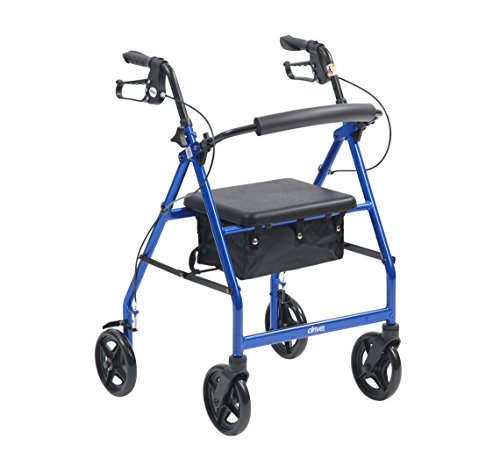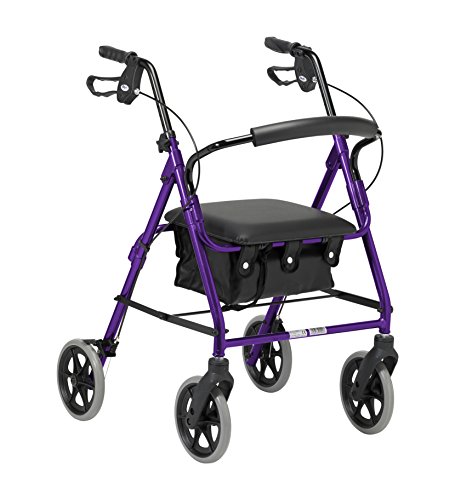What Is a
Rollator Walking Aid?
A rollator is an aid for walking that assists people to maintain their balance. It accomplishes this by increasing the base of support (BoS) while walking.
It has brakes that can be easily engaged and it is able to lock when users stop or sit on the walker. A comfortable seat and an accessory basket for storing personal items are also provided.

Stability
Rollators offer greater stability and mobility compared to traditional walkers. They are a great choice for those who have trouble maintaining their balance or need an upright base for walking. These aids to mobility help reduce the strain on joints and muscles that are healing, which may aid in faster recovery.
These mobility devices lessen the stress on joints in the lower extremities and also reduce strain on the muscles. This is achieved by distributing weight over a larger area, which may help reduce the peak pressure on the forefoot during walking downhill or on a rough surface. The use of these devices may help to reduce the pain of the forefoot by distributing the pressure of the plantar area to other foot areas.
The frame is a key element of a
rollator with footrest's stability because it supports the user's weight. The frame is usually constructed of sturdy materials like aluminum or steel and ensures that the device won't collapse or buckle under the pressure. Additionally, the handle brakes on a rollator are a vital safety feature for users who need to slow down or stop if they are going too fast or have increased their speed.

While the frame of a
rollator folding provides significant stability, it is not without limitations. The weight and size could influence the device's ability to maneuver in different conditions. Certain studies have revealed that using a walker with large wheels causes the center of gravity to shift slightly to the front, which could negatively impact the way in which the device is utilized.
This is not a problem in most situations however it is something that is worth considering when purchasing a rollator. For this reason, many professionals recommend that individuals opt for a rollator with smaller wheels if they intend to spend much of their time outside or in a variety of walking conditions. The height of the handles is important to ensure they're at the right level for the user. This will avoid shoulder and wrist pain as well as wrist fatigue.
Support
In contrast to traditional walkers, which provide a steady frame for support, rollators come with four wheels that evenly distribute weight and help individuals navigate over various terrains without risking falls. This allows them to be mobile both indoors and outside and live a more solitary life with confidence. Rollators can be customized by adding different features, such as handles, brakes that can be adjusted, and wheel sizes, to meet specific needs. Some models also come with storage and backrest options for everyday mobility and comfort.
It is essential to use a rollator in a safe manner so that you do not cause accidents. It is recommended that physical therapist or doctor oversee your transition from using the device to a mobility one. They can provide you with an official prescription for the device and recommend the best option for your particular situation.
It is also crucial to follow the instructions given by the manufacturer on how to use your Rollator. This will ensure that it is set up at the correct height and that it is comfortable with your body type. To enhance the functionality of your device, it is essential to keep it clean and well-lubricated.
If you are using a walker that is rolling make sure that you place your weight on the base, not the wheels. Leaning against the wheels could cause the unit's wheels to turn. Also, do not allow a child to ride on top of your mobility aid. This could cause the wheels to wear out faster because of the pressure.
Cost may deter some people from using the aid of walking. However, financial assistance and insurance coverage are available to help pay for the cost. For instance, Medicaid and Medicare classify a walker or rollator as durable medical equipment, which means that they are able to pay a portion of the cost. They can also be paid for by using flexible spending accounts (FSAs) as well as health savings accounts (HSAs) as well as other kinds of accounts. In the end, a rollator is an affordable and efficient device that allows you to remain mobile and self-sufficient.
Simple to Use
A
lightest rollator is a great option for people who want to stay mobile and active but need some additional support. It's easy to move and folds easily when not in use. A rollator can help improve walking performance by reducing the pressure on joints and muscles, and improving balance.
A typical rollator is a structure with two to four wheels. The wheels make it easier to move around because it doesn't require lifting the frame every time you step. Some models come with a built-in seat, so you can stop for a break when you need to.
The research is still in progress but it is believed that walking with a walker could reduce the load on certain joints and muscle groups. This could lead to less strength needed for other activities and activities, such as stair climbing or balance control when standing or squatting. This could potentially contribute to the risk of falling that is seen in older
rollator wheelchair combo users.
It is important to find a walker or rollator that feels comfortable for the user. The handle should be held at the same height as the knee nearest to it, and away from the body. Holding a walker too near the body can result in strain on the back, neck, and arms. It is also important to think about the grip of a rolling walker. If the grip isn't comfortable or does not meet the needs of a person, you can replace it with a new style. For example, if the handle is too tough or too small the grip made of foam, plastic or other soft material may be more comfortable.
It is also important to note that the walker or rollator should be kept at a safe distance from the floor in order to avoid putting too much pressure on the feet and legs. This reduces the risk of tripping and twisting an ankle or knee. It's important to have an alternate device (like crutches or a cane) to use in the event that the walker that rolls becomes unstable for reasons of any kind. It's not recommended to set the rollator down for long periods of time, especially on stairs or uneven ground.
Convenience
A rollator is a convenient mobility aid for those who are unable to walk long distances or who experience frequent falls. It can help reduce the impact of a fall and minimize the strain on injured muscles and joints. It can also boost confidence and encourage social interaction. It is important to consider the cost of a rollator and whether your insurance will cover it. Many Medicare Part B policies classify walkers and rollators as durable medical equipment and will therefore reimburse some of the cost once you've reached your annual deductible. Medicaid also typically covers these devices.
Some people choose to use rolling devices as an alternative to a cane or walker however, it's better to continue using these other devices for stability and support while walking. A walker, for instance, can help you maintain straight posture by ensuring that your arms are level with your hips. It can also be held at a level that is supportive from your body. This will help you avoid awkward positions that could result in a twisted ankle or knee.
If you choose to use a walker, it's important to keep in mind that you should never walk while putting it in the direction of your body or close to your body. Handles on a standard walker tend to be higher than the arms of the user. This can cause wrist flexion. This can result in forefoot pain and a hallux rigidus, as it reduces the muscles that flex the hands and arms. The handles of a walker with a rolling mechanism can help reduce this effect by lowering them to a position closer to the styloideus.
Another benefit of convenience is that many rollators come with a seating area that can be used when you're running errands in public venues. This is particularly helpful when you're shopping and want to relax and sit down and rest your feet. Some models include an extra tray that is placed on top of the seat. This allows you to carry snacks or beverages while walking around.
Take note of whether the model you select has a space to store things like your phone, wallet, and keys. Some models are designed with a basket on the front of the frame, whereas others have a storage area under the seat. Some walkers that roll are equipped with a backpack strap that allows for easy transportation.

 Stability
Stability While the frame of a rollator folding provides significant stability, it is not without limitations. The weight and size could influence the device's ability to maneuver in different conditions. Certain studies have revealed that using a walker with large wheels causes the center of gravity to shift slightly to the front, which could negatively impact the way in which the device is utilized.
While the frame of a rollator folding provides significant stability, it is not without limitations. The weight and size could influence the device's ability to maneuver in different conditions. Certain studies have revealed that using a walker with large wheels causes the center of gravity to shift slightly to the front, which could negatively impact the way in which the device is utilized.